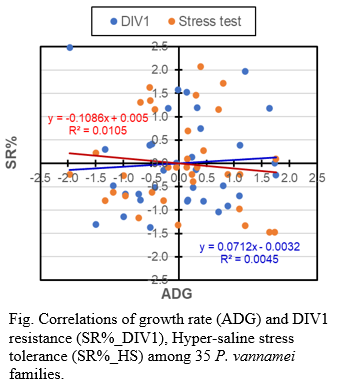PRELIMINARY INVESTIGATION OF CORRELATIONS AMONG GROWTH RATE, DIV1 RESISTANCE AND STRESS TOLERANCE OF THE PACIFIC WHITE SHRIMP Penaeus vannamei
In shrimp genetic improvement programs, fast growth, specific disease resistance and general robustness are the top three breeding goals for consideration . To properly design strategies for selective breeding, it is necessary to investigate if and how these traits are genetically correlated . The Pacific white shrimp, Penaeus vannamei, is the dominant penaeid species cultured , accounting for about two-third of the global production. Decapod iridescent virus 1 (DIV1) is an emerging shrimp viral disease, which is known to affect all stages of the Pacific white shrimp, crayfish and giant freshwater prawn and has caused tremendous economic loss . As an euryhaline species, P. vannamei can survive within a wide range of salinity , the optimal level for juvenile growth is between 15 to 25 ppt. Hyper-saline stress test can be used to evaluate the general robustness of shrimp.
In the study, 35 full- sib families of Specific-pathogen-free (SPF) P. vannamei were systemically assessed in a n eight-week growth trial, DIV1 lab challenge test and hyper-saline stress tests. Results showed that, for average initial weight of 2.5g (ranging from 1.0 to 4.0g) juvenile shrimp, the average dail y gain (ADG) of shrimp families varied from 0.38 to 0.53 g/day, and large between-family variations were detected for both DIV1 challenge test survival rates (SR%_DIV1 , from 8.0% to 68%) , and Hyper-saline stress test survival rates (SR%_HS, from 22% to 62% ). Phenotypic correlations between ADG and SR%_DIV1, SR%_HS were 0.0672, -0.1026 respectively, both were not significantly different from zero (Figure). Phenotypic correlation between SR%_DIV1 and SR%_HS was -0.3004. Further analyses revealed that such slightly negative correlation could result from the initial sizes of juvenile shrimp. The larger juveniles seemed to be more tolerant to salinity stress while the smaller juveniles tended to survive better when infected by DIV1. Based on t he results, a balanced index selection scheme is recommended for the selective breeding of P. vannamei.
